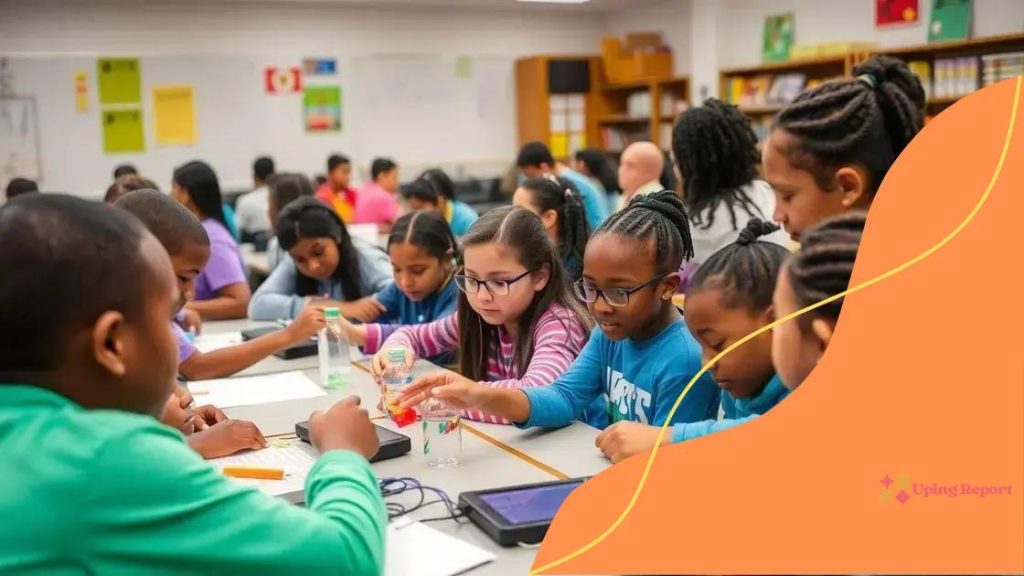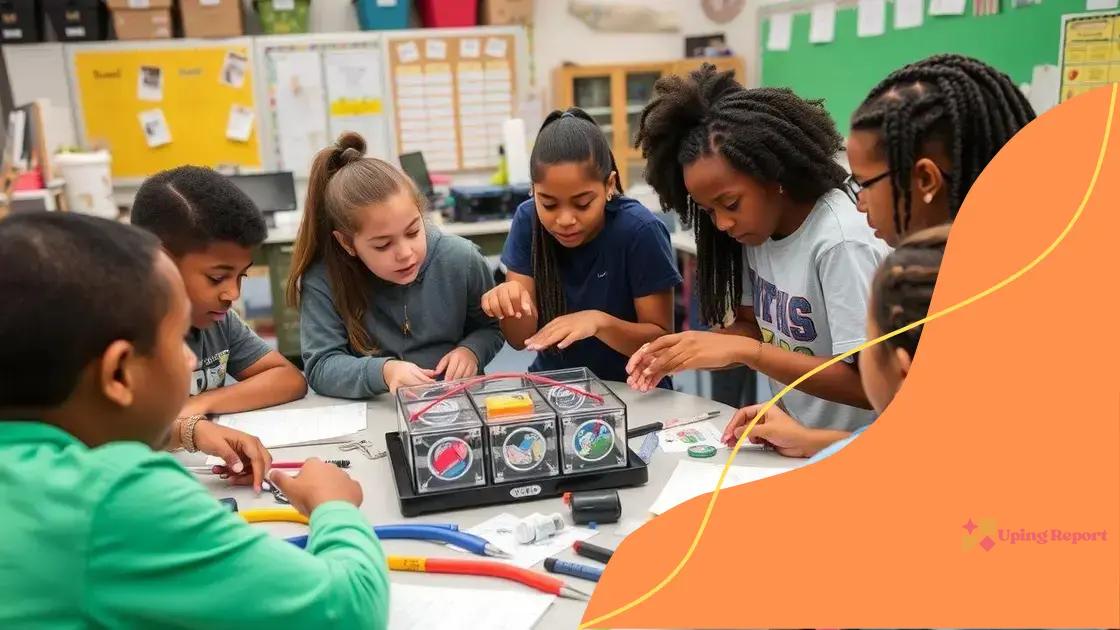STEM curriculum expansion planned: what you need to know

STEM curriculum expansion focuses on integrating interdisciplinary approaches, technology, and problem-based learning to enhance student engagement and prepare them for future job markets.
STEM Curriculum Expansion Planned is on the horizon, promising to reshape educational landscapes. But have you considered how this might affect future generations?
Understanding the importance of a STEM curriculum
Understanding the importance of a STEM curriculum is essential for preparing students for the future. In today’s technology-driven world, skills in Science, Technology, Engineering, and Mathematics are vital. Schools are recognizing that a STEM curriculum fosters critical thinking and problem-solving abilities.
Why is STEM important?
A robust STEM curriculum helps students build a strong foundation. It encourages creativity and innovation, creating a pathway for future careers. When students engage in STEM learning, they see real-world applications of their studies.
- Promotes analytical thinking
- Encourages teamwork and collaboration
- Prepares students for high-demand job markets
Furthermore, a well-rounded STEM curriculum includes hands-on experiences that make learning enjoyable. By involving students in experiments and projects, they gain a deeper understanding of concepts. This practical approach aids retention and relevance.
Benefits to students
Students immersed in a STEM curriculum tend to excel in critical thinking. They learn to approach problems methodically. This skill is valuable not only in STEM fields but across various disciplines.
- Enhances communication skills
- Builds resilience through challenges
- Stimulates interest in lifelong learning
Empowering students through a strong STEM curriculum also promotes diversity. Engaging various demographics helps to bridge gaps in representation in science and technology fields. This inclusivity ensures a wide range of ideas and innovations.
In conclusion, understanding the significance of a STEM curriculum is crucial. It equips students with skills that are essential for success in a rapidly changing world, ensuring they are ready to tackle future challenges.
Key components of the STEM curriculum expansion
The key components of the STEM curriculum expansion are essential for creating a rich learning experience. Various elements come together to form a comprehensive program. Each component plays a role in ensuring students gain the necessary skills for the future.
Interdisciplinary Approach
A successful STEM curriculum emphasizes the importance of integrating different subjects. Science, Technology, Engineering, and Mathematics should not be taught in isolation. Instead, students should see the connections between these fields.
- Hands-on projects combining science and technology
- Real-world applications of engineering principles
- Mathematics utilized in data analysis and coding
This interdisciplinary approach helps to engage students more deeply. When they apply their knowledge across subjects, understanding improves significantly.
Hands-on Learning Experiences
Another vital component is providing hands-on learning experiences. Students should participate in experiments, robotics, and other practical applications. Through these activities, they can explore concepts actively instead of passively.
- Encourages experimentation and testing ideas
- Builds critical thinking and problem-solving skills
- Increases student engagement and interest
When students are involved in active learning, they retain information better and develop a love for learning. Creating opportunities for collaboration is equally important. Group projects encourage teamwork and communication, allowing students to learn from one another.
The STEM curriculum expansion should also be inclusive. Diverse perspectives enhance creativity and promote innovation. Encouraging participation from underrepresented groups prepares students for a global workforce.
By focusing on these key components, educational institutions can design a STEM curriculum that effectively prepares students for future challenges. The goal is to create a robust system that nurtures skills needed in various careers, ensuring students are motivated and equipped for their futures.
Impact on students and learning outcomes

The impact on students and learning outcomes from a well-implemented STEM curriculum expansion is profound. This initiative not only enhances knowledge but also shapes skills that are essential in today’s world. Students exposed to meaningful STEM education become critical thinkers and problem solvers.
Academic Performance
One noticeable effect of a strong STEM curriculum is improved academic performance. Research shows that students engaged in STEM programs often achieve higher scores in math and science. They gain confidence in their ability to tackle complex problems, which encourages further learning.
- Enhanced understanding of scientific principles
- Stronger computational skills
- Increased motivation to learn
Additionally, this educational approach fosters creativity among students. When they work on projects that require innovation, they learn to think outside the box. This creativity also translates into other academic areas.
Skill Development
STEM education not only focuses on traditional learning but also cultivates soft skills. Teamwork, communication, and collaboration are essential in any career. In STEM classes, students often work in groups to solve problems, allowing them to develop these vital skills.
- Improved teamwork abilities
- Greater resilience when faced with challenges
- Enhanced communication skills
Moreover, the practical application of STEM concepts leads to better retention of knowledge. When students participate in hands-on experiments or engineering projects, they tend to remember what they learned. This retention helps them apply their knowledge to real-world situations.
The long-term effects of a STEM curriculum expansion can lead to greater career readiness. Students who have engaged in comprehensive STEM programs are often better prepared for the job market. They possess a blend of technical skills and personal qualities that employers seek.
Challenges of implementing STEM programs
The challenges of implementing STEM programs can be significant, yet addressing them is crucial for educational advancement. Schools and educators often face various obstacles when trying to integrate a comprehensive STEM curriculum.
Resource Availability
One major challenge is the availability of resources. Schools may lack access to modern technology, tools, and materials necessary for effective STEM education. Budget constraints can limit opportunities for purchasing equipment or hiring qualified staff.
- Insufficient funding for program development
- Lack of up-to-date technology and supplies
- Inadequate professional development for teachers
Moreover, teachers may not have the training needed to teach STEM subjects effectively. When educators are not confident in their abilities, it can lead to less engagement from students.
Curriculum Alignment
Another challenge involves aligning the STEM curriculum with existing educational standards. Ensuring that STEM programs meet state testing requirements can be complex. Schools often struggle with balancing traditional teaching methods and innovative approaches.
- Difficulty integrating STEM with core subjects
- Conflicting goals with standardized testing
- Need for ongoing curriculum revisions
Additionally, there is the challenge of keeping up with rapidly changing technologies. The skills required for jobs in STEM fields evolve quickly. Therefore, curricula must be updated regularly to stay relevant. This constant need for adaptation can overwhelm educators.
Finally, fostering support from parents and community members can also be difficult. Community buy-in is essential for the success of any STEM program. Resistance to change or lack of awareness can impede the growth and acceptance of these initiatives.
Future trends in STEM education
Future trends in STEM education indicate a shift towards more interdisciplinary approaches and technology integration. As the job market evolves, education must adapt to prepare students for emerging fields. Innovations in teaching methods will profoundly impact how students learn.
Increased Use of Technology
One major trend is the increasing use of technology in classrooms. Virtual reality (VR) and augmented reality (AR) are gaining popularity. These tools provide immersive learning experiences, helping students visualize complex concepts. They can explore ecosystems, conduct virtual experiments, and engage in 3D modeling.
- Enhanced engagement through interactive lessons
- Real-world simulations to foster understanding
- Accessibility to global resources and expertise
Moreover, online learning platforms are becoming more prevalent, allowing students to learn at their own pace. This flexibility enables customization of education, addressing individual learning styles and needs.
Focus on Problem-Based Learning
Another trend is the emphasis on problem-based learning (PBL). This method encourages students to work on real-world problems, enhancing critical thinking and collaboration. Through PBL, students apply their knowledge to practical situations, making learning relevant and engaging.
- Development of soft skills like teamwork
- Encouragement of self-directed learning
- Stronger retention of knowledge
Furthermore, partnerships between schools and industries are growing. This collaboration helps bridge the gap between education and the workforce. Students are given opportunities for internships and hands-on experiences, making them more competitive in the job market.
Emphasis on diversity in STEM fields is also a key trend. Programs aimed at increasing participation from underrepresented groups are on the rise. By promoting inclusive education, the STEM workforce will benefit from diverse ideas and perspectives.
FAQ – Frequently Asked Questions about STEM Education Trends
What is the role of technology in STEM education?
Technology enhances student engagement through tools like VR and AR, providing immersive learning experiences.
How does problem-based learning benefit students?
Problem-based learning encourages critical thinking and real-world problem-solving, making education more relevant and engaging.
Why is industry collaboration important in STEM?
Partnerships with industries provide students with internships and hands-on experiences, connecting education to future job opportunities.
How can diversity impact STEM education?
Promoting diversity in STEM education enriches the learning environment and encourages a broader range of ideas and solutions.
